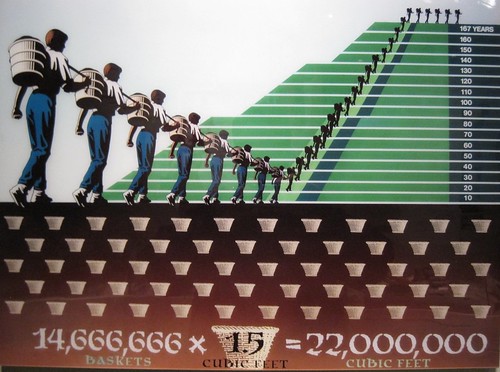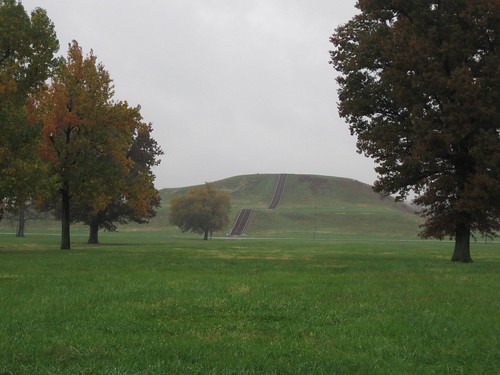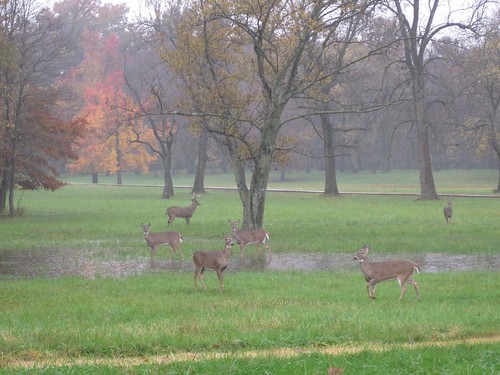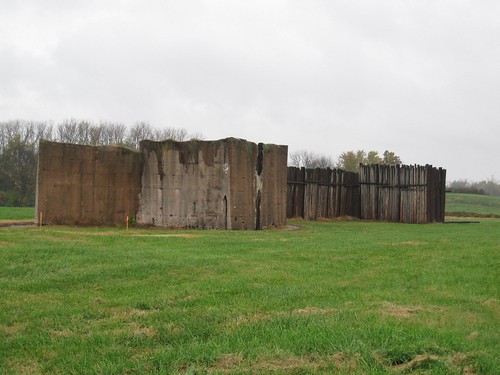 Between the 11th and 13th centuries A.D., a thriving Native American culture, known as Mississippian, supported a network of cities along the length of the Mississippi River. Their domain extended west to the foothills of the Rockies and as far east as Florida. The settlement at Cahokia (near present day St. Louis) was perhaps the largest, with as many as 20,000 inhabitants. At the time it would have been larger than the European city of London. Over time the inhabitants constructed massive earthen mounds that still stand today. The largest of these mounds encompasses a greater area than does the Great Pyramid at Giza.
Between the 11th and 13th centuries A.D., a thriving Native American culture, known as Mississippian, supported a network of cities along the length of the Mississippi River. Their domain extended west to the foothills of the Rockies and as far east as Florida. The settlement at Cahokia (near present day St. Louis) was perhaps the largest, with as many as 20,000 inhabitants. At the time it would have been larger than the European city of London. Over time the inhabitants constructed massive earthen mounds that still stand today. The largest of these mounds encompasses a greater area than does the Great Pyramid at Giza.To sustain such a large population, the culture must have been incredibly complex. We know at least that they were extraordinary farmers, growing corn, squash and seed-bearing plants. Many of the other grains that we associated with the Midwest today, like wheat, barley and oats actually arrived in the New World with the Europeans. The Cahokians initially supplemented their diet by hunting, fishing and gathering in the abundant Mississippi valley.
 As the settlement grew, the central government needed to become stronger to keep the peace and distribute the abundant harvest. As in other large Native American cultures, archaeologists believe that the leaders was revered as a living god. He took residence at the top of the largest mound, presumably for closer communication with the heavens. Monks' Mounds, so named for the French Trappist Monks who lived nearby in the early 1800s, stands over 100 ft. tall and consumes an estimated 22 million cubic feet of earth.
As the settlement grew, the central government needed to become stronger to keep the peace and distribute the abundant harvest. As in other large Native American cultures, archaeologists believe that the leaders was revered as a living god. He took residence at the top of the largest mound, presumably for closer communication with the heavens. Monks' Mounds, so named for the French Trappist Monks who lived nearby in the early 1800s, stands over 100 ft. tall and consumes an estimated 22 million cubic feet of earth. Other mounds were constructed for various purposes: for lesser government officials, burials, defense and to mark important locations. The mounds come in three forms: rectangular platforms, conical burial mounds, and triangular markers. So many mounds were created within the Cahokia site that the large excavation pits are still also visible today. They have since filled with water and enhance the aesthetic of the park.
Other mounds were constructed for various purposes: for lesser government officials, burials, defense and to mark important locations. The mounds come in three forms: rectangular platforms, conical burial mounds, and triangular markers. So many mounds were created within the Cahokia site that the large excavation pits are still also visible today. They have since filled with water and enhance the aesthetic of the park.In addition to the mounds, archaeologists have discovered the remains of some timber constructions on the site. The residents of Cahokia would have lived in wooden homes with thatch roofs. Additionally, the constructed a large palisade wall around the governmental center of the city. Experts believe that the wall was constructed late in the city's prosperous history, and does not appear to have protected the residential areas of town. This has led some to surmise that the wall was construction to protect against rebellion from within the community.
Further outside the city complex, a circular pattern of timber piles has been reconstructed. The locals have dubbed this structure "wood henge." It seems to serve a similar purpose to the mysterious Stone Henge rock construction in England. Certain perimeter posts align with the rising sun at the Spring and Fall equinoxes and the Winter and Summer solstices.
Mysteriously, the cities disbanded about 100 years before the arrival of Columbus to the New World. What lead to the abandonment of such an advanced urban culture? Depletion of resources, climate change, political upheaval and war have all been suggested as possible reasons for the decline. Sadly, these challenges appear to mirror the problems faced by our modern culture. By delving deeper into the history of the Mississippian people, can we gain a better understanding of our current situation?




![Reblog this post [with Zemanta]](http://img.zemanta.com/reblog_e.png?x-id=e4edad29-3f7a-4b85-803f-8d2b44d3cc6b)

No comments:
Post a Comment